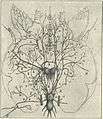Pierre Lyonnet
| Pierre Lyonnet | |
|---|---|
|
Pierre Lyonnet | |
| Born |
21 July 1706 Maastricht |
| Died |
10 January 1789 (aged 82) The Hague |
| Fields | naturalist. |
Pierre Lyonnet or Lyonet (21 July 1706 – 10 January 1789)[1] was an artist and engraver who became a naturalist.
Biography
According to the RKD he was a pupil of Hendrik van Limborch, Carel de Moor, and Jan Wandelaar.[1] He was secretary and translator (he spoke more than eight languages) for the government of the Dutch Republic.
Initially he trained as a lawyer before choosing to specialize in the engraving of natural history and the work of dissection. He illustrated Theology of the insects, or demonstration of the perfections of God in all that relates to the insects (1742) of Friedrich Christian Lesser (1692–1754) and Treatise on the polyps (1744) of Abraham Trembley (1710–1784). He then decided to make his do own observations and to write his own monograph on the anatomy of the insects. His first work appeared in 1750 under the name of Anatomical treatise of the caterpillar which corrodes the wood of Willow. He illustrated 4,041 different muscles thus. He lacked the anatomical knowledge of Jan Swammerdam (1637–1680) and of Marcello Malpighi (1628–1694) and his observations show it. His book was received with scepticism which affirmed that Lyonnet imagined the details which he drew with so much precision. It was to counter these criticisms, that he put in the second edition which appears in 1752, a drawing of its instruments and a description of its method. Lyonnet planned to study the chrysalis and the adult but, sixty years old, the tiredness of his eyes obliged him to stop his projects.
Lyonnet was elected a fellow of the Royal Society on 14 January 1748.[2]
References
- Wellmann, Janina (2008). "Picture metamorphosis. The transformation of insects from the end of the seventeenth to the beginning of the nineteenth century". NTM. 16 (2): 183–211. PMID 19227706.
- Illustrations from Traité anatomique (1750)
- larva of the willow moth
 Larva of the willow moth
Larva of the willow moth Central nervous system with the nerves
Central nervous system with the nerves Muscles
Muscles Head
Head Larva of the willow moth
Larva of the willow moth Lyonet's dissecting outfit
Lyonet's dissecting outfit
Literature
- Cryptology and statecraft in the Dutch Republic – Karl de Leeuw ISBN 90-5776-039-8
- Pierre Lyonet – W.H. Seters (1962)
